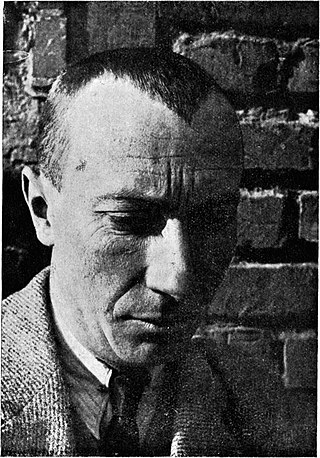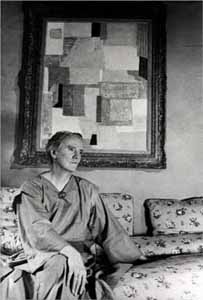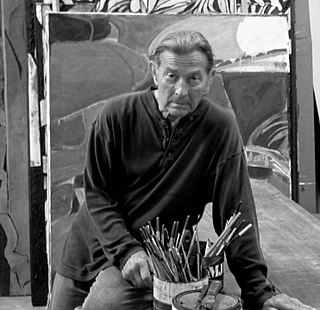Hannelore Baron (June 8, 1926 – April 28, 1987) was a German-born American artist who created highly personal, book-sized, abstract collages and box constructions, and exhibited in the late 1960s.
Hannelore Baron (June 8, 1926 – April 28, 1987) was a German-born American artist who created highly personal, book-sized, abstract collages and box constructions, and exhibited in the late 1960s.
Born in Dillingen/Saar, Germany, Baron and her family fled persecution in Nazi Germany, illegally crossing the border into Luxembourg in 1939. In 1941 Baron's family sailed from Lisbon to New York and settled in the Bronx, New York City. By the time she graduated from the Staubenmiller Textile High School in Manhattan, Baron was reading eastern philosophy, making increasingly abstract paintings and probably already experiencing the symptoms of claustrophobia and depression that would lead to a series of nervous breakdowns throughout her life. She married book dealer Herman Baron in 1950 with whom she had daughter Julie and son Mark. [1] In the late 1950s Baron combined a variety of techniques and began making her first collages. Occupied with raising her two children and beset by psychological problems, Baron nevertheless exhibited her work and in 1969, the year of her one-person exhibition at Ulster County Community College, she began to make the box constructions that would become her signature. In the early 1970s, Baron established a studio and devoted her time and energy completely to her artwork until her death in 1987. [2] Hannelore Baron was self-taught. [3]
Although her compositions are completely abstract, she considered them to be both personal and political statements. In her own words,
Everything I’ve done is a statement on the, as they say, human condition...the way other people march to Washington, or set themselves on fire, or write protest letters, or go to assassinate someone. Well, I’ve had all the same feelings that these people had about various things, and my way out, because of my inability to do anything else for various reasons, has been to make the protest through my artwork... H.B. [4]
Throughout the 1970s and 1980s her work garnered critical acclaim, along with gallery and museum exhibitions in the United States, Europe and Japan. In 1995, her work was the subject of a one-person exhibition at the Solomon R. Guggenheim Museum in New York. In 2001 her work was the subject of a traveling exhibition curated by Ingrid Schaffner and organized by the Smithsonian Institution Traveling Exhibition Service. Her works can be found in the collections of The Museum of Modern Art, New York; the Solomon R. Guggenheim Museum, New York; the Whitney Museum of American Art, New York; the Los Angeles County Museum of Art, The Art Institute of Chicago, the San Francisco Museum of Modern Art, the Museum of Fine Arts, Boston, the Minneapolis Institute of Art and the Israel Museum, Jerusalem.

The Peggy Guggenheim Collection is an art museum on the Grand Canal in the Dorsoduro sestiere of Venice, Italy. It is one of the most visited attractions in Venice. The collection is housed in the Palazzo Venier dei Leoni, an 18th-century palace, which was the home of the American heiress Peggy Guggenheim for three decades. She began displaying her private collection of modern artworks to the public seasonally in 1951. After her death in 1979, it passed to the Solomon R. Guggenheim Foundation, which opened the collection year-round from 1980.

Hans Peter Wilhelm Arp, better known as Jean Arp in English, was a German-French sculptor, painter and poet. He was known as a Dadaist and an abstract artist.

Alexander Porfyrovych Archipenko was a Ukrainian-American avant-garde artist, sculptor, and graphic artist, active in France and the United States. He was one of the first to apply the principles of Cubism to architecture, analyzing human figures into geometrical forms.

Catherine Sue Opie is an American fine art photographer and educator. She lives and works in Los Angeles, as a professor of photography at the University of California, Los Angeles.
Charmion von Wiegand (1896–1983) was an American journalist, abstract painter, writer, collector, benefactor and art critic. She was the daughter of Inez Royce, an artist, and Karl Henry von Wiegand. Karl Henry von Wiegand was the German-born journalist known for wartime reporting.

Burhan C. Doğançay was a Turkish-American artist. Doğançay is best known for tracking walls in various cities across the world for half a century, integrating them in his artistic work.

Conrad Marca-Relli was an American artist who belonged to the early generation of New York School Abstract Expressionist artists whose artistic innovation by the 1950s had been recognized across the Atlantic, including Paris. New York School Abstract Expressionism, represented by Jackson Pollock, Willem de Kooning, Franz Kline, Robert Motherwell, John Ferren, Marca-Relli and others became a leading art movement of the postwar era.

John Harvey McCracken was a minimalist artist. He lived and worked in Los Angeles, Santa Fe, New Mexico, and New York.
Larry Bell is an American contemporary artist and sculptor. He is best known for his glass boxes and large-scaled illusionistic sculptures. He is a grant recipient from, among others, the National Endowment for the Arts and the Guggenheim Foundation, and his artworks are found in the collections of many major cultural institutions. He lives and works in Taos, New Mexico, and maintains a studio in Venice, California.
Ingrid Schaffner is a curator, writer, and educator specializing in contemporary art since the mid-1980s. Schaffner work often coalesces around themes of archiving and collecting, photography, feminism, and alternate modernisms—especially Surrealism. She has curated important exhibitions that have helped studio craft to gain acceptance as fine arts, such as Dirt on Delight: Impulses That Form Clay with Jenelle Porter at the Institute of Contemporary Art, Philadelphia in 2009.
Peter Ford Young is an American painter. He is primarily known for his abstract paintings that have been widely exhibited in the United States and in Europe since the 1960s. His work is associated with Minimal Art, Post-minimalism, and Lyrical Abstraction. Young has participated in more than a hundred group exhibitions and he has had more than forty solo exhibitions in important contemporary art galleries throughout his career. He currently lives in Bisbee, Arizona.

Anne Ryan (1889–1954) was an American Abstract Expressionist artist associated with the New York School. Her first contact with the New York City avant-garde came in 1941 when she joined the Atelier 17, a famous printmaking workshop that the British artist Stanley William Hayter had established in Paris in the 1930s and then brought to New York when France fell to the Nazis. The great turning point in Ryan's development occurred after the war, in 1948. She was 57 years old when she saw the collages of Kurt Schwitters at the Rose Fried Gallery, in New York City, in 1948. She right away dedicated herself to this newly discovered medium. Since Anne Ryan was a poet, according to Deborah Solomon, in Kurt Schwitters’s collages “she recognized the visual equivalent of her sonnets – discrete images packed together in an extremely compressed space.” When six years later Ryan died, her work in this medium numbered over 400 pieces.
Alfred Julio Jensen was an abstract painter. His paintings are often characterized by grids of brightly colored triangles, circles or squares, painted in thick impasto. Conveying a complex web of ideas, often incorporating calligraphy or numerical systems, they are frequently referred to as "concrete" abstract art. After his death in 1981, the Guggenheim organized a major retrospective of his work, having held his solo exhibition there in 1961.

James Jarvaise was an American painter based in Southern California.
James Welling is an American artist, photographer and educator living in New York City. He attended Carnegie-Mellon University where he studied drawing with Gandy Brodie and at the University of Pittsburgh where he took modern dance classes. Welling transferred to the California Institute of the Arts in Valencia, California in 1971 and received a B.F.A. and an M.F.A. in the School of Art. At Cal Arts, he studied with John Baldessari, Wolfgang Stoerchle and Jack Goldstein.

Edward Dugmore was an abstract expressionist painter with close ties to both the San Francisco and New York art worlds in the post-war era following World War II. Since 1950 he had more than two dozen solo exhibitions of his paintings in galleries across the United States. His paintings have been seen in hundreds of group exhibitions over the years.

Frank Lobdell (1921–2013) was an American painter, often associated with the Bay Area Figurative Movement and Bay Area Abstract Expressionism.
George Earl Ortman was an American painter, printmaker, constructionist and sculptor. His work has been referred to as Neo-Dada, pop art, minimalism and hard-edge painting. His constructions, built with a variety of materials and objects, deal with the exploration off visual language derived from geometry—geometry as symbol and sign.
John Millard Ferren was an American artist and educator. He was active from 1920 until 1970 in San Francisco, Paris and New York City.

Françoise Grossen is a textile artist known for her braided and knotted rope sculptures. She lives and works in New York City. Grossen’s work has been acquired by the Metropolitan Museum of Art, New York; the Renwick Gallery, Smithsonian American Art Museum, Washington, DC; and the State Hermitage Museum, Saint Petersburg, Russia.